Abstract
Primary repair of esophageal atresia restores gastrointestinal continuity, but does not ensure normal esophageal function. To date 22 patients, six to 32 (average 15) years after repair of their esophageal atresias, have been evaluated by personal interview and esophageal manometrics and acid reflux testing. Previous barium swallow examinations had demonstrated varying degrees of anastomotic narrowing (12 patients), abnormal esophageal motor function (11 patients), gastroesophageal reflux (two patients), and hiatal hernia (one patient). Ten patients experience intermittent dysphagia for solid foods. Seven have typical symptoms of gastroesophageal reflux. Esophageal function tests including manometry and intraesophageal pH recording, have demonstrated varying abnormalities of esophageal motility in 21 patients and moderate to severe gastroesophageal reflux in 13. Two patients have required reconstruction of the esophagogastric junction for control of severe reflux esophagitis. The unexpected high incidence of gastroesophageal reflux in these patients, coupled with their abnormal esophageal motility which impairs normal acid clearing, renders them more prone to reflux esophagitis. Careful long-term evaluation for gastroesophageal reflux and its complications is indicated following primary repair of esophageal atresia. Evaluation of esophageal function with intraesophageal pressure and pH recordings is a far more sensitive indicator of esophageal physiology than the barium swallow examination.
Full text
PDF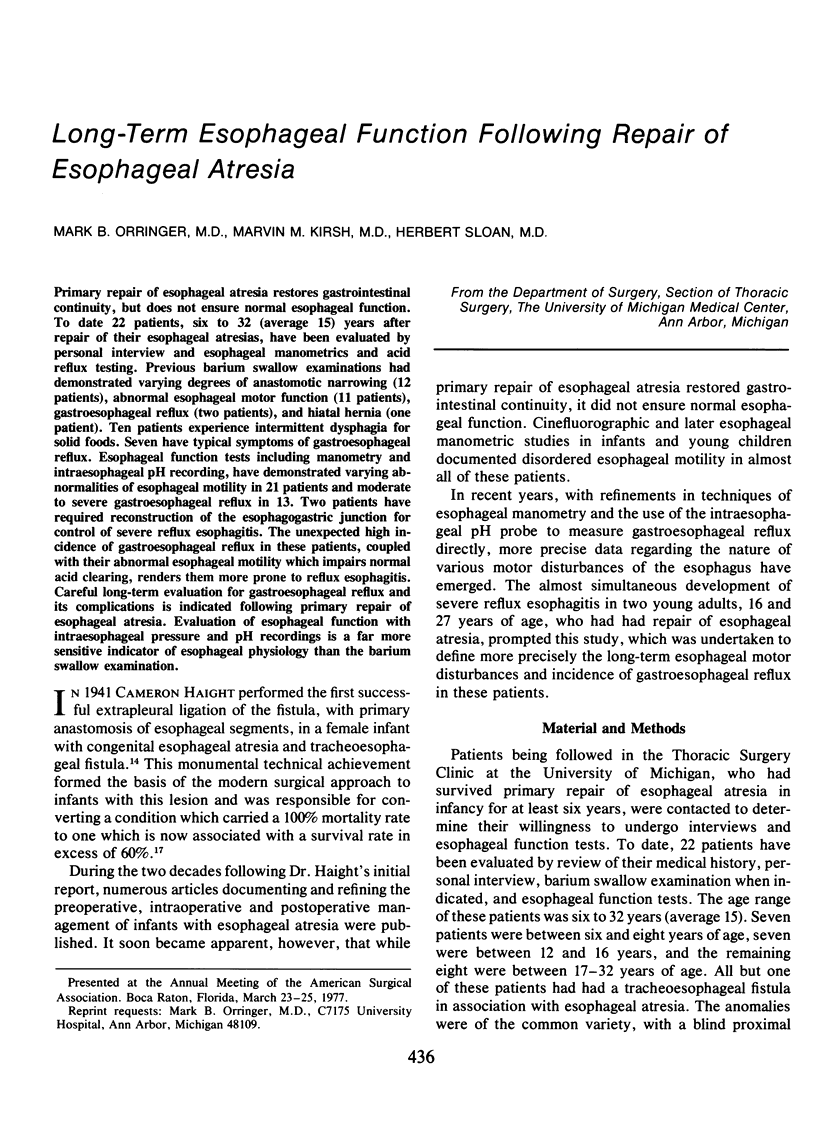
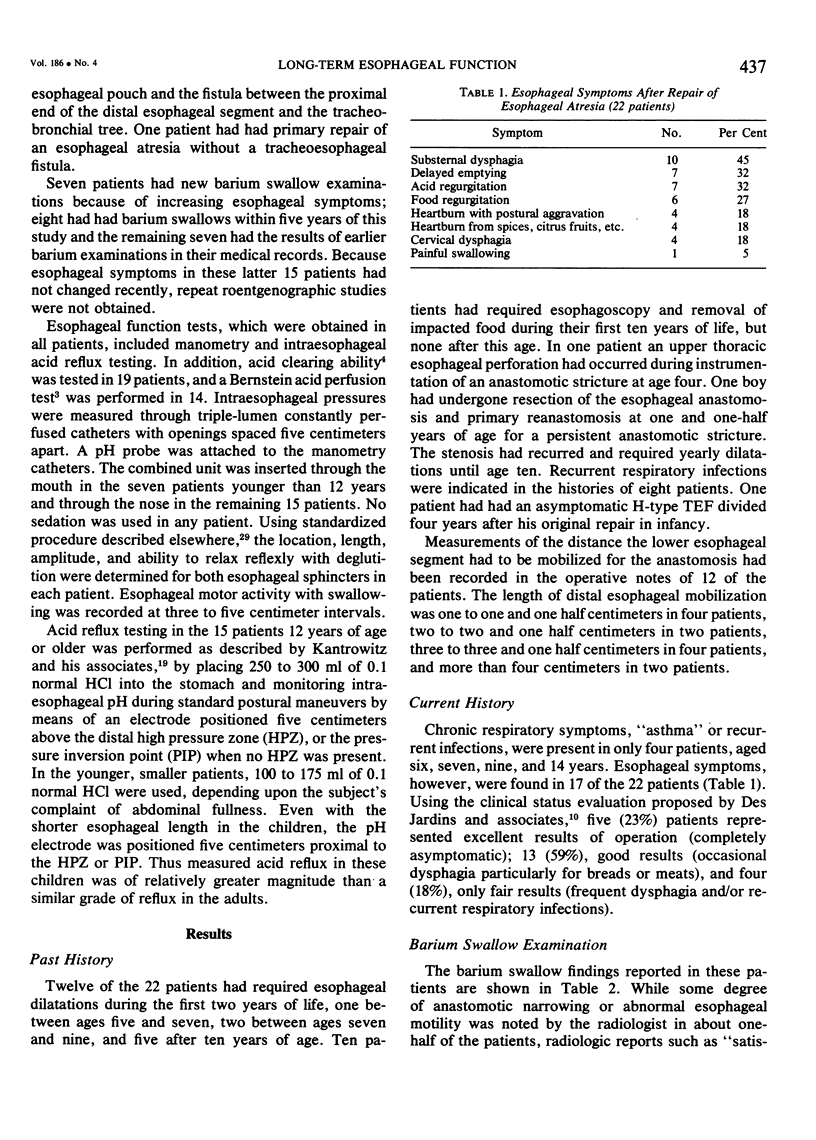
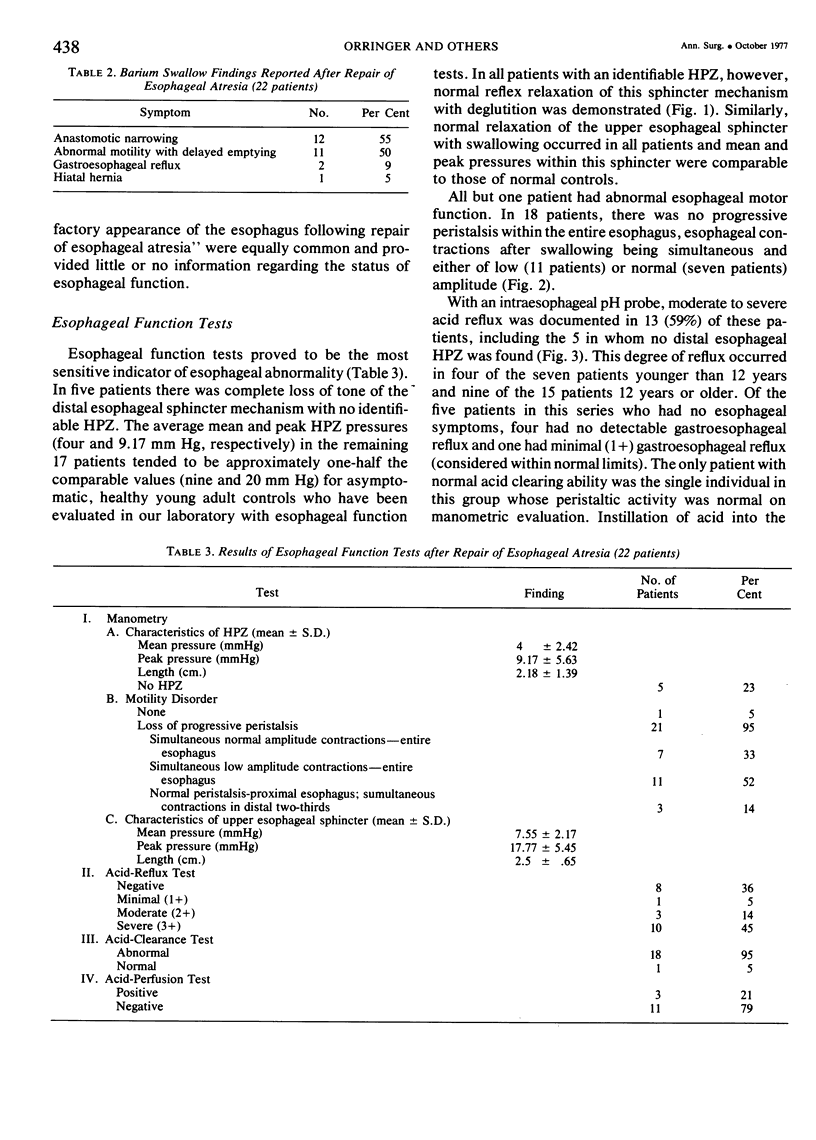
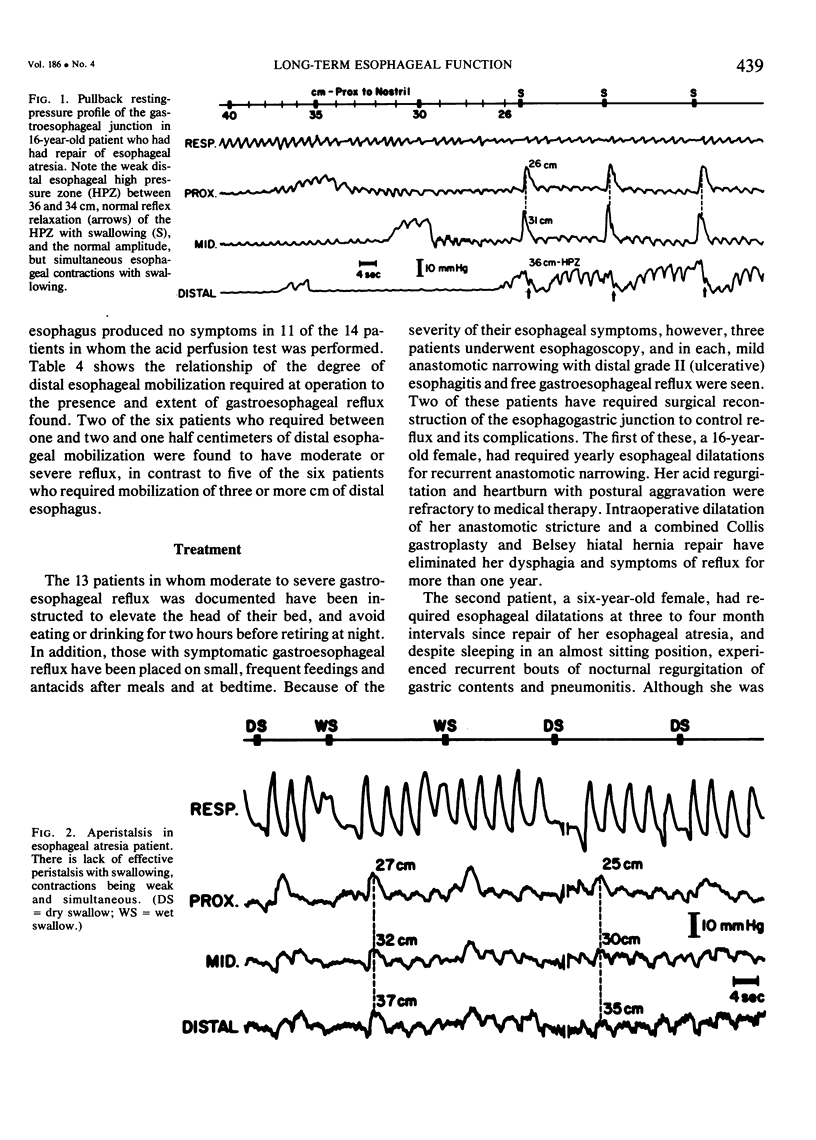

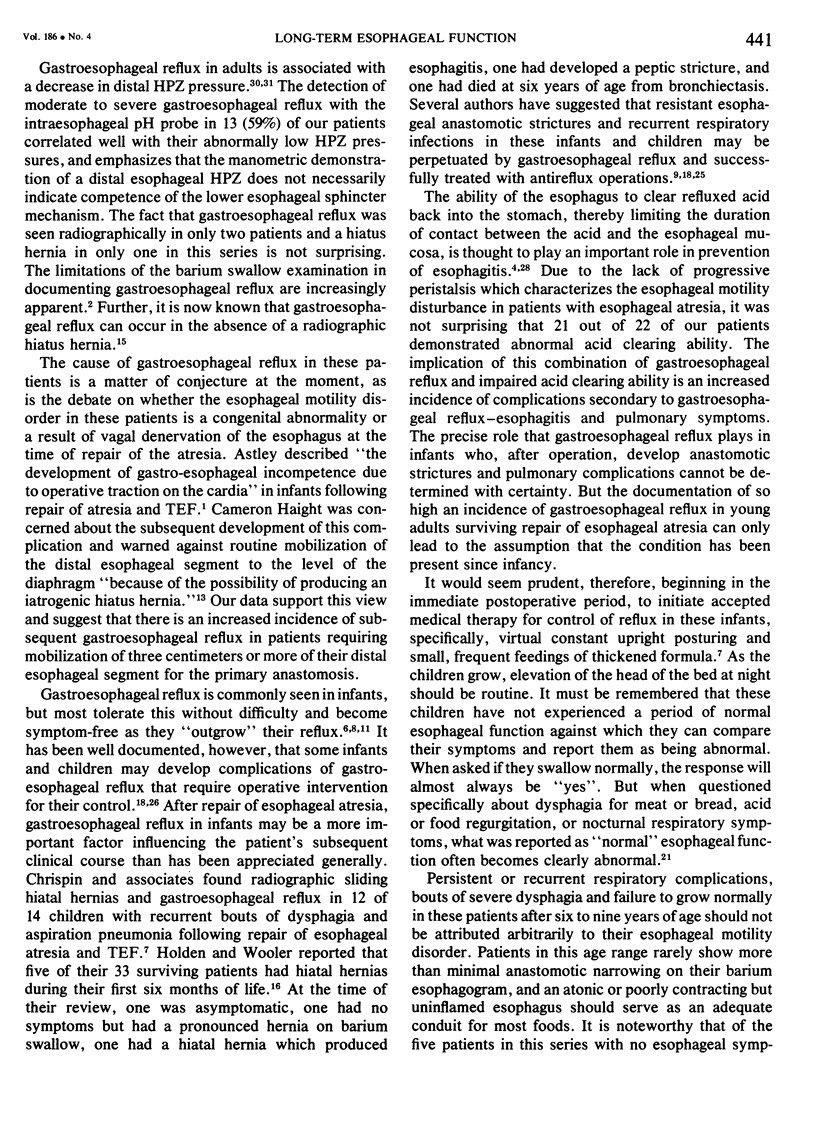
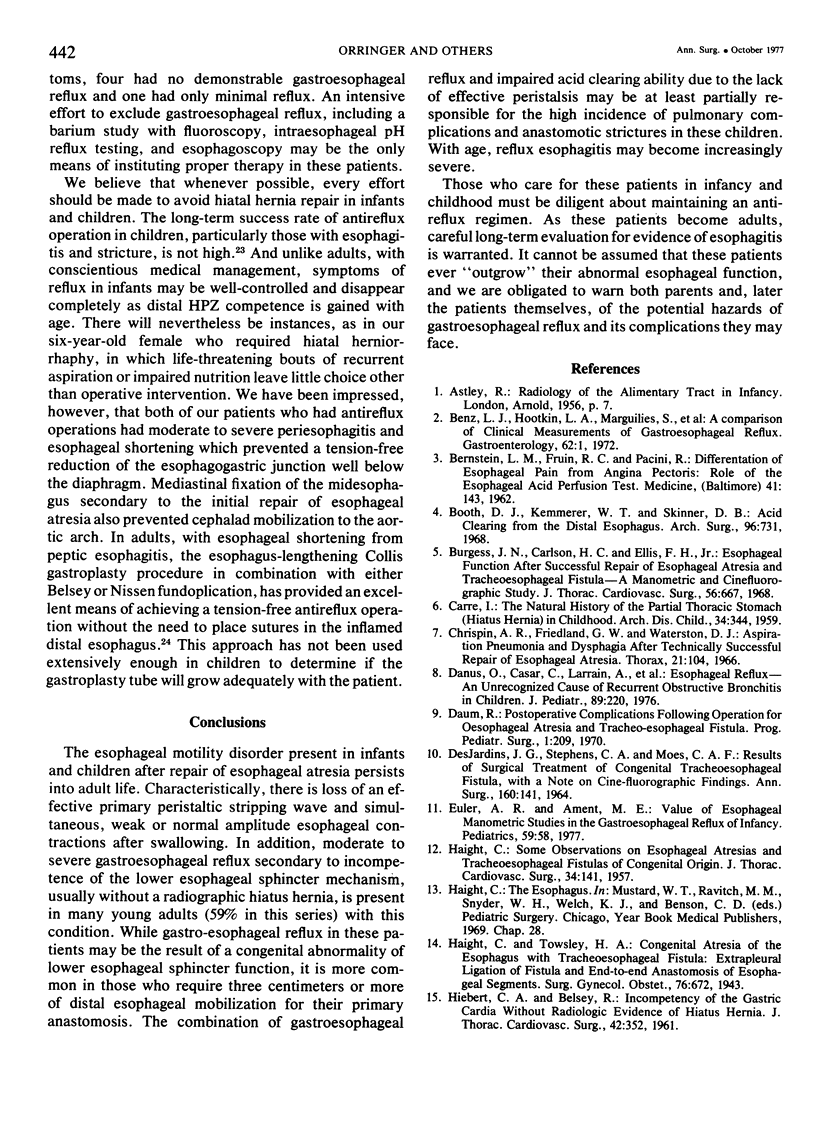
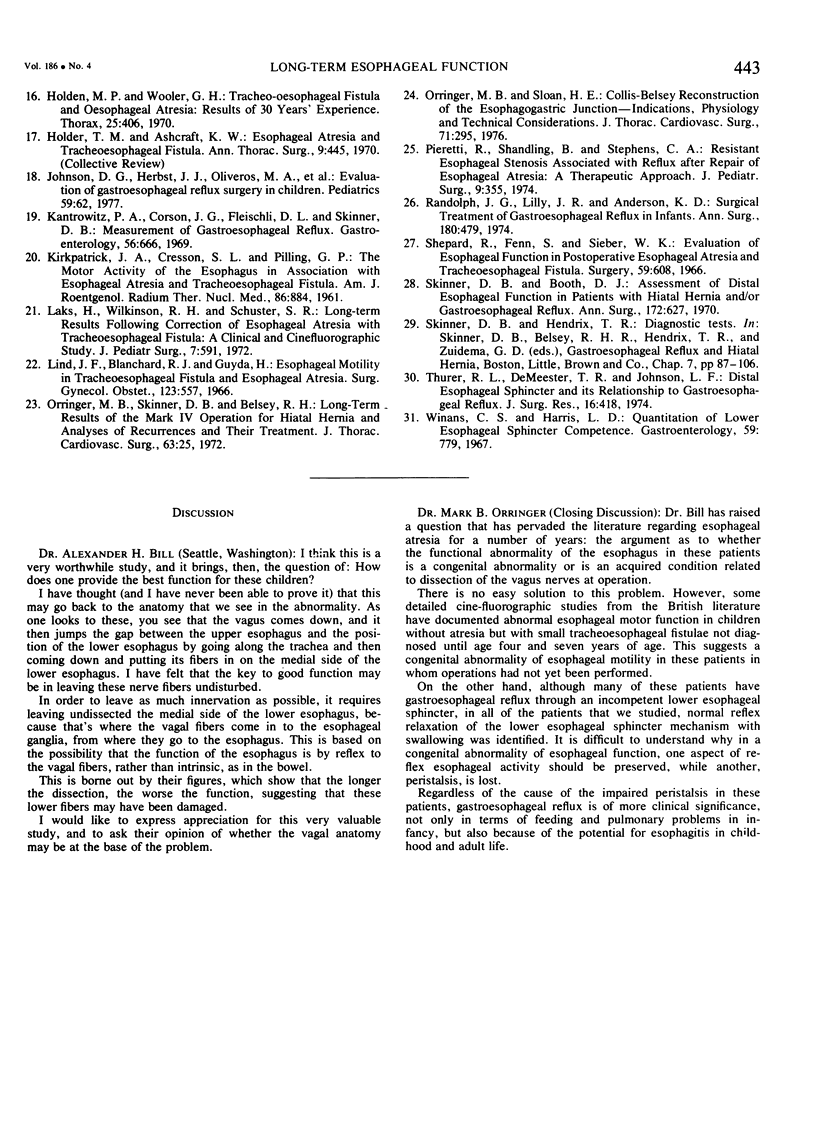
Selected References
These references are in PubMed. This may not be the complete list of references from this article.
- BERNSTEIN L. M., FRUIN R. D., PACINI R. Differentiation of esophageal pain from angina pectoris: role of the esophageal acid perfusion test. Medicine (Baltimore) 1962 May;41:143–162. doi: 10.1097/00005792-196205000-00002. [DOI] [PubMed] [Google Scholar]
- Benz L. J., Hootkin L. A., Margulies S., Donner M. W., Cauthorne R. T., Hendrix T. R. A comparison of clinical measurements of gastroesophageal reflux. Gastroenterology. 1972 Jan;62(1):1–5. [PubMed] [Google Scholar]
- Booth D. J., Kemmerer W. T., Skinner D. B. Acid clearing from the distal esophagus. Arch Surg. 1968 May;96(5):731–734. doi: 10.1001/archsurg.1968.01330230039006. [DOI] [PubMed] [Google Scholar]
- Burgess J. N., Carlson H. C., Ellis F. H., Jr Esophageal function after successful repair of esophageal atresia and tracheoesophageal fistula. A manometric and cinefluorographic study. J Thorac Cardiovasc Surg. 1968 Nov;56(5):667–673. [PubMed] [Google Scholar]
- CARRE I. J. The natural history of the partial thoracic stomach (hiatus hernia) in children. Arch Dis Child. 1959 Aug;34:344–353. doi: 10.1136/adc.34.176.344. [DOI] [PMC free article] [PubMed] [Google Scholar]
- Chrispin A. R., Friedland G. W., Waterston D. J. Aspiration pneumonia and dysphagia after technically successful repair of oesophageal atresia. Thorax. 1966 Mar;21(2):104–110. doi: 10.1136/thx.21.2.104. [DOI] [PMC free article] [PubMed] [Google Scholar]
- DESJARDINS J. G., STEPHENS C. A., MOES C. A. RESULTS OF SURGICAL TREATMENT OF CONGENITAL TRACHEO-ESOPHAGEAL FISTULA, WITH A NOTE ON CINE-FLUOROGRAPHIC FINDINGS. Ann Surg. 1964 Jul;160:141–145. doi: 10.1097/00000658-196407000-00020. [DOI] [PMC free article] [PubMed] [Google Scholar]
- Danus O., Casar C., Larrain A., Pope C. E., 2nd Esophageal reflux--an unrecognized cause of recurrent obstructive bronchitis in children. J Pediatr. 1976 Aug;89(2):220–224. doi: 10.1016/s0022-3476(76)80452-0. [DOI] [PubMed] [Google Scholar]
- Euler A. R., Ament M. E. Value of esophageal manometric studies in the gastroesophageal reflux of infancy. Pediatrics. 1977 Jan;59(1):58–61. [PubMed] [Google Scholar]
- HAIGHT C. Some observations on esophageal atresias and tracheoesophageal fistulas of congenital origin. J Thorac Surg. 1957 Aug;34(2):141–172. [PubMed] [Google Scholar]
- HIEBERT C. A., BELSEY R. Incompetency of the gastric cardia without radiologic evidence of hiatal hernia. The diagnosis and management of 71 cases. J Thorac Cardiovasc Surg. 1961 Sep;42:352–362. [PubMed] [Google Scholar]
- Holden M. P., Wooler G. H. Tracheo-oesophageal fistula and oesophageal atresia: results of 30 years' experience. Thorax. 1970 Jul;25(4):406–412. doi: 10.1136/thx.25.4.406. [DOI] [PMC free article] [PubMed] [Google Scholar]
- Holder T. M., Ashcraft K. W. Esophageal atresia and tracheoesophageal fistula. Ann Thorac Surg. 1970 May;9(5):445–467. doi: 10.1016/s0003-4975(10)65538-5. [DOI] [PubMed] [Google Scholar]
- KIRKPATRICK J. A., CRESSON S. L., PILLING G. P., 4th The motor activity of the esophagus in association with esophageal atresia and tracheoesophageal fistula. Am J Roentgenol Radium Ther Nucl Med. 1961 Nov;86:884–887. [PubMed] [Google Scholar]
- Kantrowitz P. A., Corson J. G., Fleischli D. J., Skinner D. B. Measurement of gastroesophageal reflux. Gastroenterology. 1969 Apr;56(4):666–674. [PubMed] [Google Scholar]
- Laks H., Wilkinson R. H., Schuster S. R. Long-term results following correction of esophageal atresia with tracheoesophageal fistula: a clinical and cinefluorographic study. J Pediatr Surg. 1972 Oct-Nov;7(5):591–597. doi: 10.1016/0022-3468(72)90218-7. [DOI] [PubMed] [Google Scholar]
- Lind J. F., Blanchard R. J., Guyda H. Esophageal motility in tracheoesophageal fistula and esophageal atresia. Surg Gynecol Obstet. 1966 Sep;123(3):557–564. [PubMed] [Google Scholar]
- Orringer M. B., Skinner D. B., Belsey R. H. Long-term results of the Mark IV operation for hiatal hernia and analyses of recurrences and their treatment. J Thorac Cardiovasc Surg. 1972 Jan;63(1):25–33. [PubMed] [Google Scholar]
- Orringer M. B., Sloan H. Collis-Belsey reconstruction of the esophagogastric junction. Indications, physiology, and technical considerations. J Thorac Cardiovasc Surg. 1976 Feb;71(2):295–303. [PubMed] [Google Scholar]
- Pieretti R., Shandling B., Stephens C. A. Resistant esophageal stenosis associated with reflux after repair of esophageal atresia: a therapeutic approach. J Pediatr Surg. 1974 Jun;9(3):355–357. doi: 10.1016/s0022-3468(74)80292-7. [DOI] [PubMed] [Google Scholar]
- Randolph J. G., Lilly J. R., Anderson K. D. Surgical treatment of gastroesophageal reflux in infants. Ann Surg. 1974 Oct;180(4):479–486. doi: 10.1097/00000658-197410000-00013. [DOI] [PMC free article] [PubMed] [Google Scholar]
- Shepard R., Fenn S., Sieber W. K. Evaluation of esophageal function in postoperative esophageal atresia and tracheoesophageal fistula. Surgery. 1966 Apr;59(4):608–617. [PubMed] [Google Scholar]
- Skinner D. B., Booth D. J. Assessment of distal esophageal function in patients with hiatal hernia and-or gastroesophageal reflux. Ann Surg. 1970 Oct;172(4):627–637. doi: 10.1097/00000658-197010000-00009. [DOI] [PMC free article] [PubMed] [Google Scholar]
- Thurer R. L., Demeester T. R., Johnson L. F. The distal esophageal sphincter and its relationship to gastroesophageal reflux. J Surg Res. 1974 Apr;16(4):418–423. doi: 10.1016/0022-4804(74)90063-8. [DOI] [PubMed] [Google Scholar]


